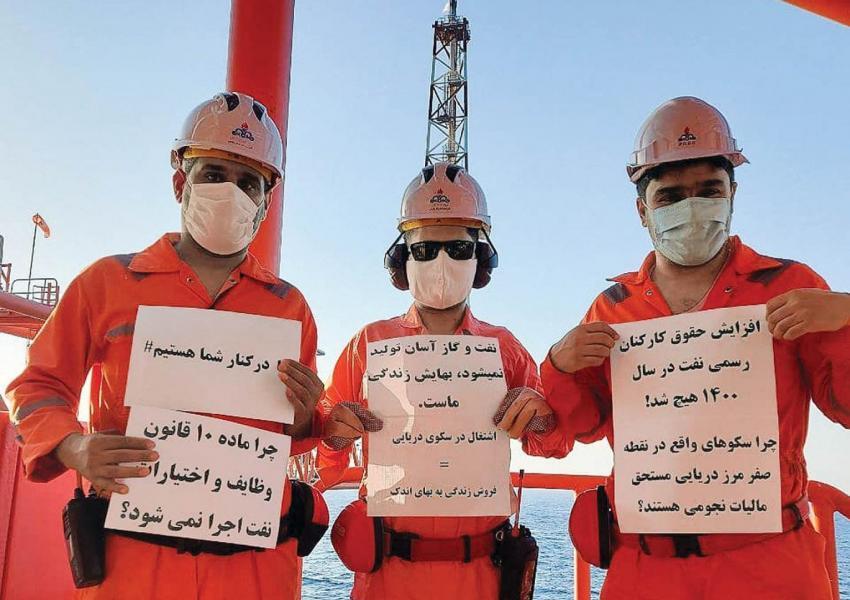A nationwide strike by Iranian oil and gas workers on fixed-term contracts — which started a day after the June 18 Iranian presidential elections — has spread to 112 oil, gas, and petrochemical companies in at least eight of the provinces that house Iran’s main oil and gas centers. The strikes are the biggest workers’ protest since the oil workers’ strikes in late 1978, which brought the U.S.-backed shah’s regime to its knees.
The widespread demonstrations underscore the growing economic pressures placed on a country that is living under crippling U.S. sanctions and that is facing a fifth wave of the pandemic. In the past month more than 120,000 mostly temporary and contract workers have taken part in the strike. They have refused to work and joined rallies and hunger strikes outside Iran’s strategic refineries and power plants.
These workers’ demands include an increase in wages as inflation rises, wages that are paid on time, and back pay. Many workers complain that they haven’t been paid in months. The workers are also demanding better working conditions, improved health and safety standards, and freedom of association and protest. Their main demands, however, are to end contract employment, to ban the firing of workers, to reinstate the 700 protesting workers who were recently fired, and to abolish special economic zones, which allow employers to skirt labor protections.
The workers have also called for independent organizations of the working class across all sectors of labor. Since independent unions are not recognized in Iran, the wildcat strike action is coordinated by strike committees, including the Council for Organizing Contract Oil Workers’ Protests, which organizes 41,000 contract workers in the oil industry. The workers, mainly contracted scaffolders, fitters, welders, and electricians, have announced that they will not return to work unless their demands are met.
The growth of strikes by oil and petrochemical workers — the beating heart of the country’s economy and the clerical government’s main source of foreign exchange — has led many to believe that these strikes could become a turning point in the history of workers’ protests and strikes against the ayatollahs’ regime, installed more than four decades ago.
The expansion of these strikes, which recently grew to include the militant workers of the Haft Tappeh Sugarcane Factory, can have a rapid and paralyzing effect in all parts of the country, bringing solidarity from other industrial branches in the face of the country’s deep economic crisis, caused not only by the U.S. imperialist blockade but also by the repressive regime, which represents the interests of Iran’s ruling elite.
Though the Iranian regime is known to crack down hard on protesters, workers are now entering the national scene more prominently and using methods like wildcat strikes. As a result, the use of conventional methods of repression is thrown into question. Furthermore, dissatisfied workers in the energy sector represent a threat of a much higher, given that hydrocarbons are the government’s main economic artery and that petroleum workers have played a historic role in the country’s politics.
At the same time, the rapid spread of workers’ strikes across Iran, coinciding with the election of a new government in Iran, has made it more likely that strikes will spread to other sectors of labor and trade unions. This further complicates the unstable situation in the Middle East, where a revolting sector of working youth has played an active and important role on the streets in recent years and has been joined by an increasingly dynamic labor movement, like the Iranian one, that is gaining experience in struggle and organization.
The current strike in many ways continues a monthlong wave of strike action by more than 10,000 workers that took place in the South Pars oil and gas fields last summer. The 2020 strike action forced employers to improve wages and living conditions, but one year later, as the social crisis in Iran has deepened and a new administration is preparing to take power, the strikes have expanded in both scope and scale.
The Birth of the Wildcat Strike
It all started in Assaluyeh, a city in southern Iran where the temperature regularly reaches 50 degrees Celsius (122 degrees Fahrenheit). The dust sticks to the eyes and noses of workers and fills their mouths. Construction workers have to go into cities surrounded by burning pipes for long hours for 20 consecutive days until they get their well-deserved (but inadequate) rest.
After each day under the intense sun, as one worker recounts, the workers’ dorms are not a refuge but an additional source of suffering. They are extensive camps of overcrowded workers, living with little water and no private space for a meager salary that barely amounts to $200 a month. The workers live in these quarters, separated from their families, which they rarely visit because it is too expensive to visit their far-off homes and because they lack days off.
Eventually, 10,000 workers who were stationed in conditions resembling a forced labor camp said enough is enough! On June 20, they launched a wildcat strike in the region’s refineries and petrochemical plants. Social networks such as Twitter, Telegram, and WhatsApp facilitated the spread of the strike, and soon workers joined in from the rest of the oil centers in Khuzestan, Isfahan, Ilam, Tehran, and West Azerbaijan. In these regions labor is similarly precarious: workers have no medical or labor protections, and they face ideological and trade union persecution.
The beginning of the strike coincided with the triumph of Ebrahim Raisi in the presidential elections — the hardline candidate handpicked for the presidency by the Islamic Republic of Iran’s supreme leader, Ali Khamenei. These most recent elections had historically low rates of voter turnout, aided by a boycott campaign of workers and activists — in a clear and generalized rejection of the Iranian political caste.
The Strikes Continue
Thus far thousands of workers have paralyzed part of the beating heart of the Iranian economy. In addition, their actions have aroused various sectors of the labor movement in Iran to join the strikes in solidarity, dubbing the coordinated actions the “1400 Campaign” (the year 2021 in the Persian calendar).
The protests, however, have not yet reached the state-owned National Iranian Oil Company, where some 200,000 workers have central oil production in their hands, receive wages three times higher than contractors’, and enjoy better protections under Iran’s labor law. These “permanent” or “official” workers not only receive more privileges but are under the strict control by the state.
With a policy of “divide and rule,” the Iranian regime has stopped hiring permanent workers in many oil fields, and as thousands of older workers retired, their positions were replaced by young workers on a temporary and contract basis, with wages up to eight times lower than a permanent worker. This practice of stratifying workers has also spread among smaller and newly emerging companies in the oil, petrochemical, and construction industries, mostly located in special economic zones, which have the authority to override national labor laws. Though the state ownership of oil was a conquest of the 1979 Islamic Revolution, the clerical state has acted on behalf of business interests to erode this and other popular achievements.
According to the Central Bank of Iran, living in the capital, Tehran, costs 110 million rials ($440) a month, while other cities cost 100 million rials ($400). Meanwhile, the minimum wage for subcontracted workers is around 25 million rials ($100) a month, and their maximum wage is just over 40 million rials ($160). The dire economic situation that Iranian workers face is compounded by rising inflation, which currently exceeds 50 percent. Food prices in Iran have risen about 70 percent in the last 12 months, and the national currency has depreciated eight times in the last three years. Many Iranians say they can’t afford basic food staples and are being pushed into poverty owing to low wages. At the moment, 60 percent of the 90 million Iranians live in poverty.
The roots of these economic woes can be traced to the “maximum pressure” sanctions imposed in 2018 by former president Donald Trump after the withdrawal from the nuclear deal signed by major world powers. The objective of the sanctions was regime change in Iran, and since Joe Biden took office, the criminal sanctions and aggressive rhetoric have continued, even though Biden has publicly stated his intention to return to the agreement. Thus far, diplomats have fought to resurrect the agreement, but it is the subject of internal disputes among the Biden administration’s foreign policy advisors.
As the nuclear deal hangs in the balance and the coronavirus pandemic continues to deliver blows to Iran’s economy, Iran has witnessed dozens of strikes and protests daily in various cities and industries over salary, retirement, and pension issues in recent months as the additional strain of the coronavirus pandemic has left many employers, even state entities, struggling to pay salaries. This labor activism underscores the mounting economic pressures on the country as it struggles to secure relief from imperialism’s crushing sanctions and were sporadic owing to the long-standing ban on independent workers’ organizing in Iran. The oil workers’ national strike, however, has given a new weight to these worker actions.
The Prospects of the Oil Strikes
The oil workers’ strike has aroused enormous sympathy from other labor sectors in the country. Healthcare workers, teachers, autoworkers, and truck drivers have all expressed their solidarity. Many of them are also fighting separately, such as the agro-livestock workers, but the oil workers may hegemonize them all. Public support for the strike has been expressed by many important unions, such as the Haft Tappeh Workers Union, the Free Union of Iranian Workers, the Department of Pensioners Union, and the retirees of the Council of Iran, a group of employed and retired teachers and families who seek justice for their loved ones killed during the nationwide protests in November 2019.
Other social sectors, like students, intellectuals, and activists who were active in the November 2019 wave of unrest in Iran, have shared the slogan “Workers are now following the voice of November.”
Many permanent oil workers have expressed their solidarity with the contract workers. Some staged a strike over their working conditions but ended the strike under pressure from the Oil Ministry. If the permanent workers went on strike in full force, alarm bells would start ringing for the government, since these workers have the power to affect the production process in the beleaguered oil industry. Already, President Hassan Rouhani and Oil Minister Bijan Namdar Zangeneh are promising to increase the salaries of the official and state sectors of the oil industry in an effort to prevent the spread of the strikes. Iran’s incoming president, Raisi, a figure from the judiciary who has been responsible for persecuting, imprisoning, and torturing all opposition to the regime, including union leaders, might take an even firmer stance.
On the other hand, Raisi has good ties with the contractor bosses, and his strategy may involve making some concessions when he takes office in August to calm the protests and persecute the strike leaders. Raisi is likely counting on the shaky nuclear talks in Vienna to be concluded as quickly as possible so that the U.S. sanctions can be lifted, frozen assets can be freed up, and oil exports can return to previous levels.
Either way, the Islamic Republic is facing an increasingly precarious position, leading many political commentators to speculate whether the Islamic Republic will begin collapsing during a conjunction similar to that of the Shah’s regime when it collapsed. The oil strikes that paralyzed the Iranian economy in 1978 valorized the role of the Iranian working class and especially the oil workers, who continue to be feared by the Islamic-bourgeois regime, given their strategic position within both the Iranian and the world economy.
The struggles for wages and working conditions in 1978 led the oil workers, alongside other working-class sectors, to build self-organizing bodies — the shoras. It took years for the clerical-military regime to discipline and repress the working class after that revolutionary gesture.
The current unrest among energy-sector workers doesn’t match the intensity of the protests of 42 years ago, when a massive revolutionary movement already in the streets gave the permanent oil workers the self-confidence to go on strike in their tens of thousands, and which also rapidly politicized the strikes. But the widespread dissatisfaction with the country’s political leadership mirrors the discontent of the 1970s. The regime’s legitimacy is at its lowest ebb since the revolution, as evidenced by the low electoral turnout.
At the same time, the sectors that were awakened to fight relentlessly during the two recent waves of class struggle, in 2017–18 and 2019–20, remain politically active even though their leaders are persecuted and imprisoned. These popular struggles, as an outcome of widespread discontent with economic liberalization and the sanctions regime, have called into question the exploitation and oppression of a neoliberal clerical-military regime and the economic conditions wrought about by imperialist sanctions.
The battle of the contracted oil workers reflects the growing hostility to neoliberalism among broad sectors of the working classes in Iran and elsewhere, as reflected by a banner that students unrolled in December 2019 in Tehran to support the nationwide protests: “Iran, France, Lebanon, Chile … The same struggle. Down with neoliberalism.” And as one oil worker said, “Hopefully, our voices are heard all over the world.”
For the struggle to advance, it will be key to establish unity between the striking contract workers and the permanent workers who have the power to affect production. If permanent oil workers were to join the strikes, then the oil workers could have the strength to take up broader demands that affect the popular masses in Iran in the face of both the clerical-military regime and the imperialist sanctions imposed by the United States. At the same time, the striking workers must advance in a direction independent of all political wings that seek to meddle in this strike, like former president Mahmoud Ahmadinejad or those who try to negotiate quickly with the regime without developing this struggle to the end.
The oil strike has taken important steps. Its triumph could be a great blow to the regime, and it could inspire the region’s exploited and oppressed who fight back against both capitalism and imperialism — which has drowned the region in fratricidal wars while exploiting its resources. As an interviewed worker says, “Morale is incredibly high, and they have the will to continue the strike until the end. We will be victorious. I have no doubts.”












